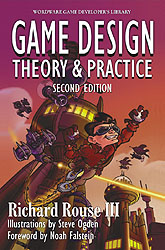Game Design: Theory & Practice
This book approaches design by examining existing games. I don't know whether he intended the book to come across this way, but it feels like Rouse has used the book to take a trip down 'memory lane', name-checking all his favourite games.
Interestingly, this approach contrasts with the view stated by Neil Thompson (speaking at BAF Game 2012), who suggested that too much retrospection can lead to stagnation in design; that designers need to expose themselves to fresh, new ideas from other disciplines.Lots of classic arcade games are reviewed, with interviews with the designers. This is certainly insightful but also frequently irrelevant -- for example, in the interview with Steve Meretzky, there is a full page of biographical ramblings relating to the decision to develop Zork Zero, with heavy name-dropping of former colleagues from over 20 years ago.
Rouse states that players want several things:
- A challenge
- To socialise or a dynamic solitary experience
- Bragging rights (i.e. something to show off about)
- An emotional experience
- To explore
- To fantasise
- To interact
- Consistency of design
- To understand their boundaries
- Reasonable logic and a fair chance
- To have clear directions and not get stuck
- An incremental experience, without boring repetition
- Immersion; to do rather than watch.
Rouse then splits the game into elements: gameplay (i.e. mechanics), technology & narrative. He states that "Experienced game designers already understand the limitations placed on the creation of games by the technology, gameplay and story."
This reveals two startling things about Rouse's approach to game design:
Firstly, Rouse does NOT include aesthetics in his list of major elements -- with only 3 pages within the 700-page book it's clear that Rouse considers it a minor factor in level design!A quick look at Rouse's game design CV suggests that most of his commercial work in the last 10 years has focused being a lead designer, game story writer & occasional programmer. He obviously knows what he's talking about, but I suspect that he may have a viewpoint biased against visual creative arts.
Secondly, he views mechanics, technology & narrative as "limitations". Schell takes a more positive approach, describing them as "essential", asking "Are four elements in harmony, reinforcing each other, and working together toward a common theme?" There is a clear split in tone between the authors.
I find myself quite disappointed at Rouse's apparent dismissal of aesthetics.
With nostalgia forming a focus for my work, it has become clear very quickly that aesthetics are a major emotional trigger -- every bit as important as narrative in motivating the player emotionally, and adding to their subjective experience.
In summary, I find Rouse's approach in this book to be functional rather than inspirational. There are many parts which show the procedures involved in game design, but the whole thing lacks any kind of creative spark. A disappointment.

